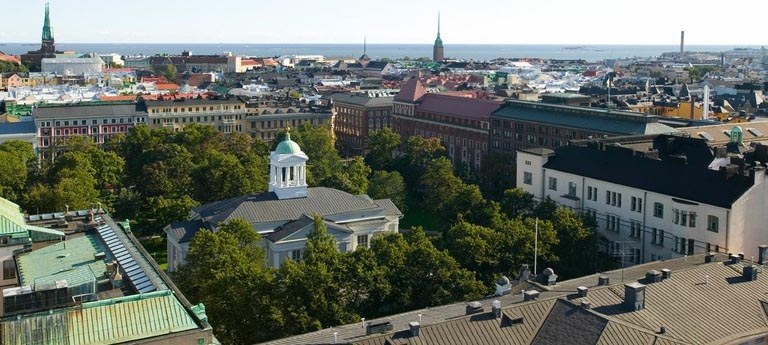Old Church

The Old Church was designed by the creator of the Empire era centre of Helsinki, Carl Ludvig Engel. The church was meant to be temporary when the Ulrika Elonora church at the current Senate Square was condemned to make way for the construction of the city centre. The church, which was funded with the salt duty money granted by the Czar, was completed by Christmas 1826.
Movables left over from the auction of the Ulrika Eleonora church were moved to the church, for example, an altar frame, organ, chandelier, benches, and the still used pulpit decorated with gilding. Helsinki Cathedral (earlier also known as St. Nicholas church and Great Cathedral) was already under construction, but was only completed a quarter of a century later. Due to its temporary nature, the Old Church was built of wood and no bells were acquired for it. Later the bells were been replaced with electric clockwork.
The Rococo style flagon (1760) in the Old Church also comes from the Ulrika Eleonora church. The historic articles of the church include a communion cloth embroidered with angels, dating back to the 18th or 19th century. Even restoration has not fully removed some old wine stains from the silk fabric.
In place of the altarpiece, there was at first a wooden gilded cross on a sky blue background, designed by Engel. Court painter, Robert Wilhelm Ekman's, work, Jeesus siunaa lapsia (Jesus blessing children) (1846-1848) was originally meant to be the altarpiece of the current Cathedral, but on the orders of the representative of the ruler, it was placed in the Old Church in 1854. The organ of the Ulrika Eleonora church was replaced with an organ made by Per Larsson Åkerman in 1869. It has 32 stops.
According to Sakari Topelius, even as late as the 1860s the most notable wedding couples were wed and the most redeemed deceased were buried in the Old Church. The Old Church is still one of the most popular wedding churches in Helsinki.
The Old Church is surrounded by the Old Church Park, which was already a cemetery before the Old Church was built. People began to call it Ruttopuisto (plague park) when victims of the plague epidemic that killed two thirds of the city residents were buried there during the Greater Wrath in 1710. The park gate, designed by Carl Ludvig Engel, includes a memorial plaque of the fatal year. In the north-eastern corner of the cemetery are the crypt of merchant, Johan Sederholm, and monument of H.C. Reuterskiöld, also designed by Engel. The last people buried in the old cemetery were those killed in the occupation of Helsinki in 1919.
The Old Church was thoroughly renovated under the supervision of the National Board of Antiquities and Historical Monuments in 1988-1990. The church is used by the Helsinki Cathedral parish.
Celebrations at the church
Members of the church can organise a baptism, a wedding or a funeral free of charge in the church.
The Old Church seats about 1200. There is no other facility for festive gatherings in connection with the church.






